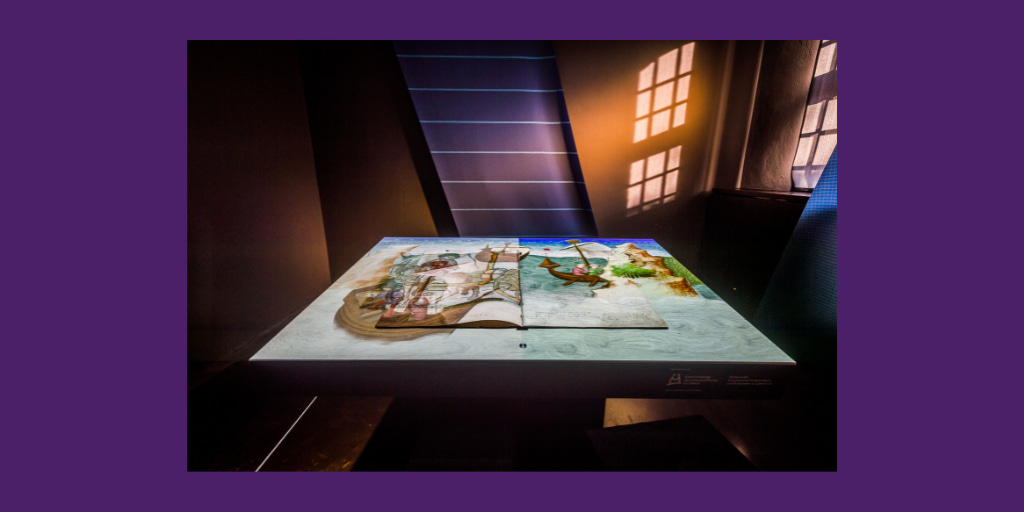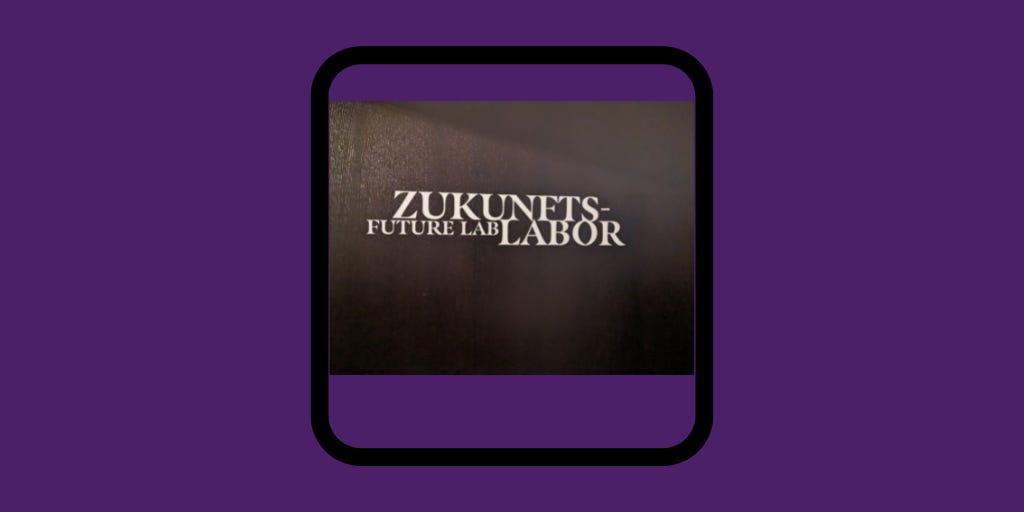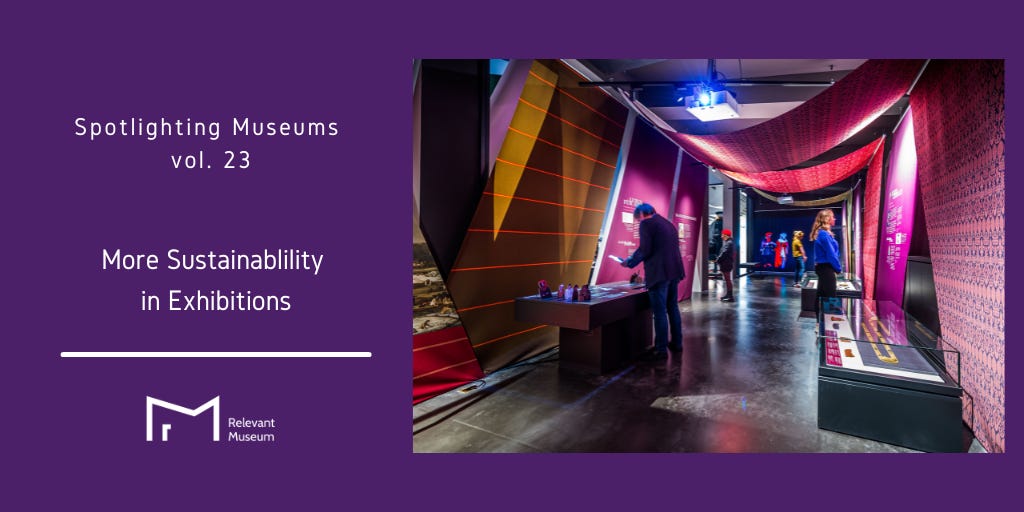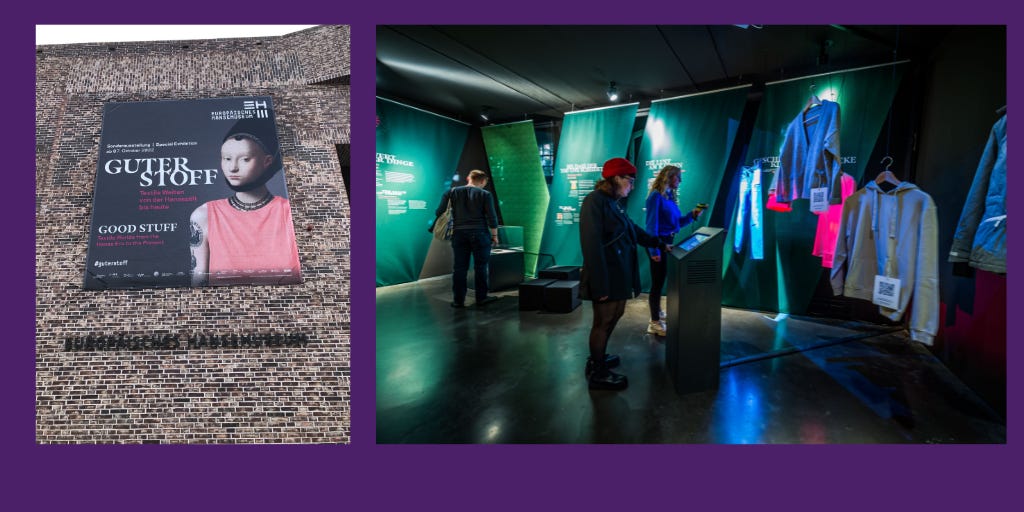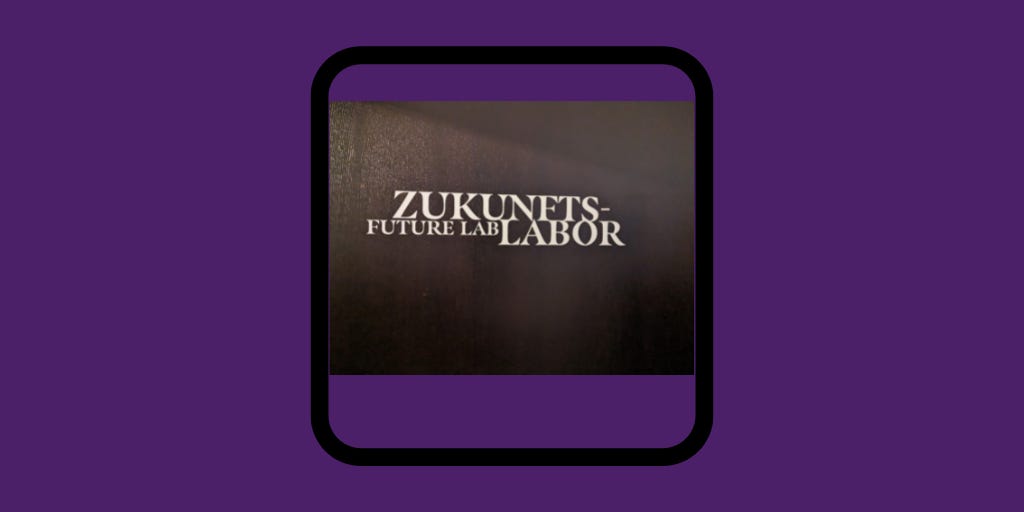Spotlighting Museums, vol. 23
Mehr Nachhaltigkeit in Sonderausstellungen - More Sustainability in Exhibitions
Please find the English Version below
Foto: Olaf Malzahn
Schön, dass Sie heute mit dieser Februar-Ausgabe ins Europäische Hansemuseum nach Lübeck mitreisen. Wir hören, wie aktuelle Fragen des nachhaltigen Konsums in dem Haus der Hanse-Historie gedacht, diskutiert und in der Praxis angewendet werden.
Das Europäische Hansemuseum Lübeck ist Mitglied bei #MuseumsForFuture und legt großen Wert auf Nachhaltigkeit und Ressourcenschonung. Sören Affeldt und Frida Santelmann vom Europäischen Hansemuseum haben uns erklärt, wie diese Haltung die Entwicklung und Nachnutzung ihrer Sonderausstellung prägt.
So wurde seit Planungsbeginn der aktuellen Sonderausstellung „Guter Stoff. Textile Welten von der Hansezeit bis heute.” bei allen Bestandteilen darauf geachtet, dass diese soweit es möglich ist, langfristig weitergenutzt bzw. alternativ an Dritte zur Weiterverwendung abgegeben werden können.
Upcycling einer Ausstellung
Gezeigt wird in der Sonderausstellung, wie Textilien vergangene und heutige Gesellschaften vernetzen und dass Nachhaltigkeit damals wie heute lebenswichtig war und ist.
„Die vielen Stoffbahnen, auf denen Texte und Bilder zu finden sind, wurden nicht nur ausgewählt, da sie thematisch sehr gut zu der Ausstellung passen. Sondern auch weil sie aus Recycling-Material bestehen und sich gut weiterverarbeiten lassen.“, so Affeldt.
Kurzlebigen Produkten, die früher auf den Müll gewandert wären, ein zweites Leben zu geben, ist eine Säule für nachhaltigere Sonderausstellungen im Europäischen Hansemuseum.
Foto: Olaf Malzahn
Im Anschluss an die Ausstellung sollen Taschen und ähnliche Gebrauchsgegenstände aus den bunten Bahnen hergestellt werden. Diese werden im Museumsshop zu Gunsten eines guten Zwecks zum Verkauf stehen. Auch das große Werbebanner an der Außenfassade wird zu Taschen weiterverarbeitet. So können die Besucher:innen noch lange ein Stück „guten Stoff“ mit sich umhertragen.
Die ressourcenschonende Planung
Eine nachhaltige Planung erfordert von Projektleitung und Gestaltungsfirma Anpassungsfähigkeit und Flexibilität. Da sämtliche Vitrinen aus dem Bestand genommen wurden, mussten sich die Objekte den Gegebenheiten anpassen und nicht anders herum.
Frida Santelmann betont: „Das bedeutet nicht, dass wir Objekte verändert haben, sondern dass wir bei der Auswahl der gezeigten Stücke schon darauf geachtet haben, dass sie auch in die Vitrinen passen. Ähnliches gilt auch für viele andere Bereiche der Ausstellungsplanung: Technik, wie Bildschirme und Medienstationen, die für die Sonderausstellung neu angeschafft werden mussten, werden für nächste Ausstellungen aufbewahrt.”
Foto: Olaf Malzahn
Eine ganz besondere Medienstation wurde von Anfang an so geplant und gestaltet, dass sie in die Dauerausstellung übernommen werden kann: „Das Lebende Buch“ erklärt den hansischen Textilhandel am Beispiel London und wird dauerhaft in die neue Inszenierung des englischen Hansekontors ziehen.
Partizipation im „Zukunftslabor”
Nachhaltigkeit spielt bei „Guter Stoff” aber nicht nur bei der baulichen Umsetzung eine Rolle, sie ist auch thematisch in der Ausstellung ein wichtiger Fokus. Besonders in den Bereichen „Nachhaltigkeit“ und „Zukunftslabor“ werden die aktuellen Probleme der textilen, besonders der Bekleidungsindustrie, thematisiert.
Die Besucher:innen lernen Stoffe aus aktueller Entwicklung und Wege im Umgang mit Textilien kennen. Nachhaltige und alternative Konsumformen, textile Lieferketten und Innovationen im textilen Feld können reflektiert werden und textiles Upcycling am XXL-Webrahmen getestet werden.
Fotos: Charleen Bergmann, Olaf Malzahn
In der Sonderausstellung dient das „Zukunftslabor” gleichzeitig als Workshopraum: Für Upcycling-Workshops sowie zwei Schulprogramme, die auf unterschiedliche Weise die Ziele der Bildung für nachhaltige Entwicklung (BNE) beleuchten.
Die Ausstellung im Digitalen
Alle Ausstellungen sollen in hoher Qualität gescannt werden. Als „3D Scan“ bleibt „Guter Stoff” nach ihrem realen Abschluss vollständig virtuell begehbar - vergleichbar mit einer ihrer Vorgängerinnen: Störtebeker & Konsorten - Piraten der Hansezeit?. Dieses Angebot kann z.B. von Lehrkräften für spannende Unterrichtseinheiten genutzt werden. Auch Menschen, die die Ausstellung nicht besuchen konnten, haben so die Möglichkeit, sie zu erleben.
In den Räumen des Europäischen Hansemuseums selbst ist die Ausstellung „Guter Stoff – Textile Welten von der Hansezeit bis heute“ noch bis zum 23. April 2023 zu sehen. Ein Ausstellungs-Blog greift Themen zum nachhaltigen Handeln auf.
Für diese Einblicke danken wir sowohl Frida Santelmann als auch Sören Affeldt. Zusammen mit wechselnden Teamkolleg:innen ist Sören seit 2020 prägendes Mitglied des Programms „Das relevante Museum“.
Uns bleibt, Ihnen ein paar sonnige Frühlingstage zu wünschen. Wir freuen uns, wenn Sie bei der nächsten Ausgabe wieder reinschauen.
Herzliche Grüße
Katja Stark
English Version
Photo: Olaf Malzahn
It's great that you are traveling with this February issue to the European Hansemuseum in Lübeck. We hear how current issues of sustainable consumption are thought about, discussed and applied in practice in the House of Hanseatic History.
The European Hansemuseum Lübeck is a member of #MuseumsForFuture and focusses on sustainability and resource conservation. Sören Affeldt and Frida Santelmann from the European Hansemuseum explained to us how this attitude shaped the development of their current exhibition.
Right from the beginning of planning of “Good stuff. Textile worlds from the Hanseatic period to today.” care has been taken to ensure that parts can be reused in the long term or alternatively given to third parties for further use.
Upcycling an exhibition
The exhibition shows, how textiles connect past and present societies and that sustainability was and is vital then as now.
“The many fabric panels, on which texts and images can be found, were not only chosen because they fit the exhibition very well thematically. But also because they are made from recycled material and are easy to process,” says Affeldt.
Giving a second life to short-lived products that would have previously gone to waste is a pillar for more sustainable exhibitions at the European Hansemuseum.
Photo: Olaf Malzahn
After the exhibition, bags and similar everyday objects will be made from the colourful material. These will be sold in the museum shop for a good cause. The large advertising banner on the outside facade is also processed into bags. In this way, visitors can carry a piece of “good stuff” with them for a long time to come.
Sustainable Resource Management
Sustainable planning requires adaptability and flexibility from the project management and design company. Since all showcases were taken out of stock, the objects had to adapt to the circumstances and not the other way around.
Frida Santelmann emphasises: “This does not mean that we have changed objects, but that we have already made sure when selecting the pieces shown that they also fit into the showcases. The same applies to many other areas of exhibition planning: Technology such as screens and media stations that had to be purchased for the exhibition are kept for the next exhibitions.”
Photo: Olaf Malzahn
A very special media station was planned and designed from the start in such a way that it can be included in the permanent exhibition: “The Living Book” explains the Hanseatic textile trade using the example of London and will move permanently to the new room of the English Hanseatic office.
Participation in the "Future Lab"
With “Good Stuff”, sustainability not only plays a role in the structural implementation, it is also an important content focus of the exhibition. The current problems of the textile, especially the clothing industry, are addressed particularly in the areas of “Sustainability” and the “Future Lab”.
The visitors get to know modern fabrics and ways of dealing with textiles differently. Sustainable and alternative forms of consumption, supply chains and innovations in the textile industry can be reflected on and textile upcycling can be tested on the XXL weaving frame.
Fotos: Charleen Bergmann, Olaf Malzahn
In the exhibition, the “Future Lab” also serves as a workshop room: for upcycling workshops and two school programmes that illuminate the goals of education for sustainable development in different ways.
Taking the exhibition digital
It is planned to have all exhibitions scanned in high quality. As a “3D scan”, “Good Stuff” will remain virtually accessible after it has officially ended - comparable to: Störtebeker & Co. - Pirates of the Hanseatic Age?. This offer can be used, for example, by educators as exciting learning units. Even people who could not visit the exhibition have the opportunity to experience it virtually.
In the rooms of the European Hansemuseum itself, the exhibition “Good stuff- textile worlds from the Hanseatic period to today” can be seen until 23rd April 2023. An exhibition blog takes up topics related to sustainable everyday life.
We thank both, Frida Santelmann and Sören Affeldt for these insights. Together with alternating team colleagues, Sören has been a member of the “Relevant Museum” programme since 2020.
For now, I wish you some fine sunny spring days. We look forward to welcoming you again to the next issue.
Best wishes
Katja Stark





